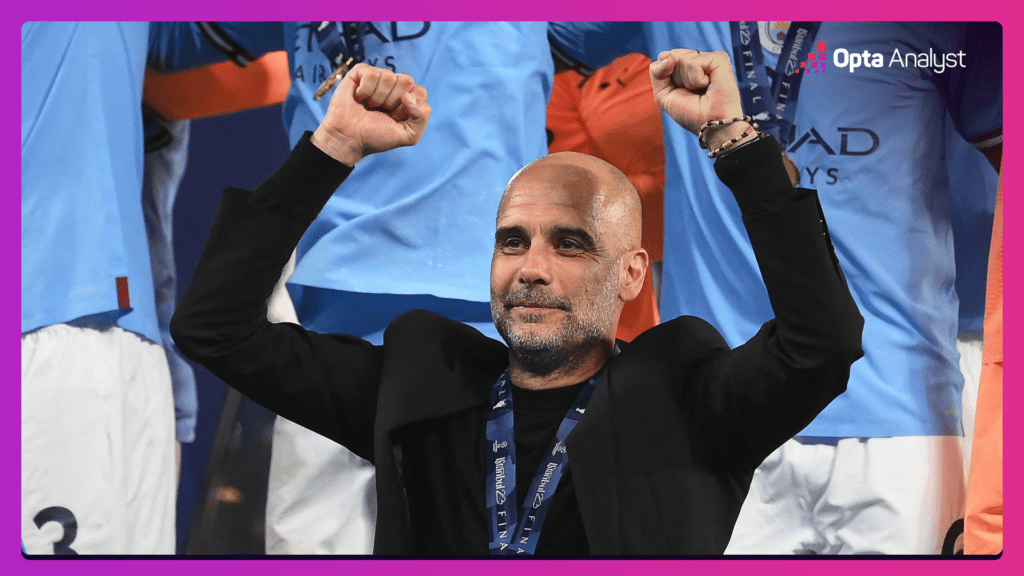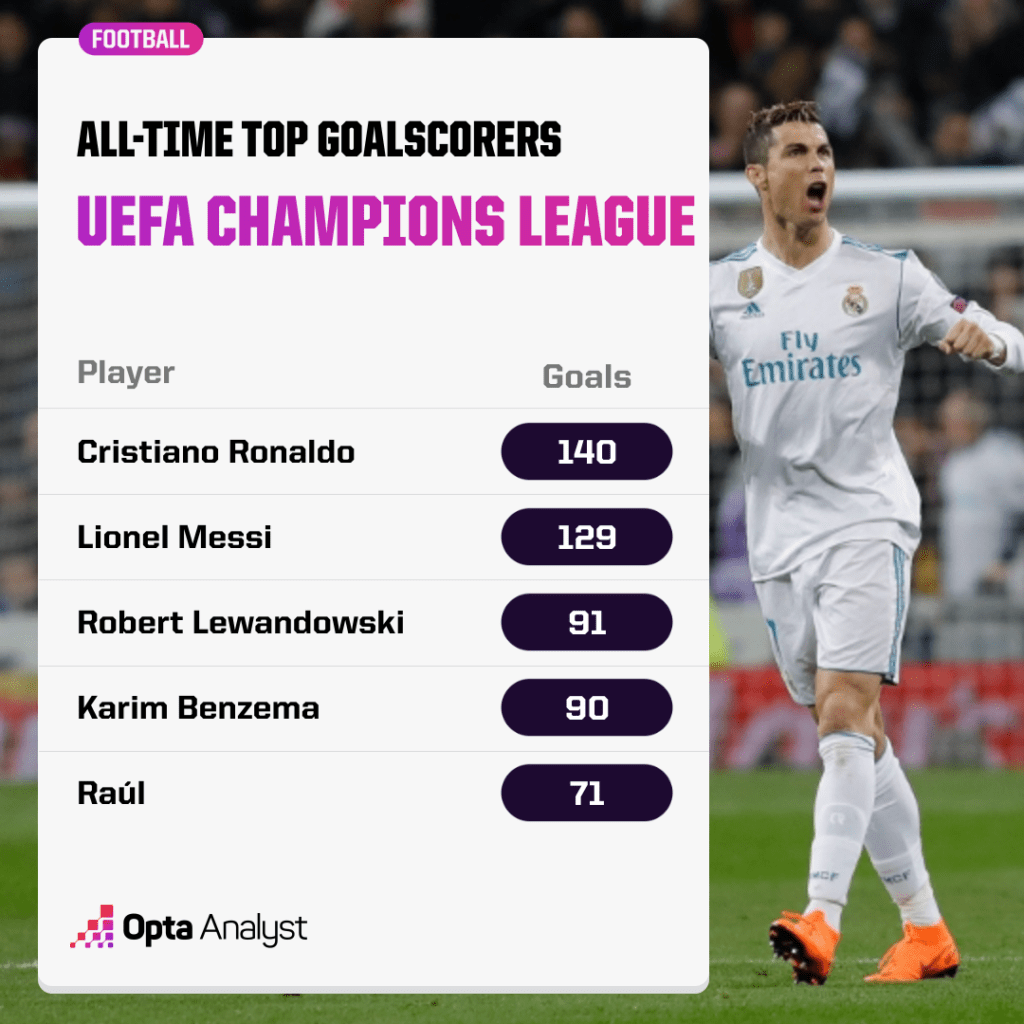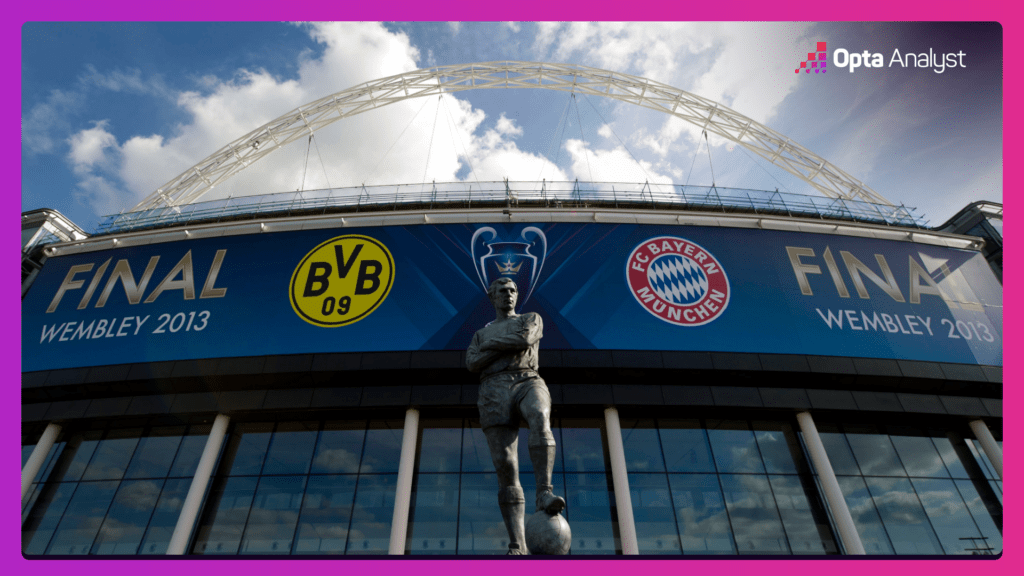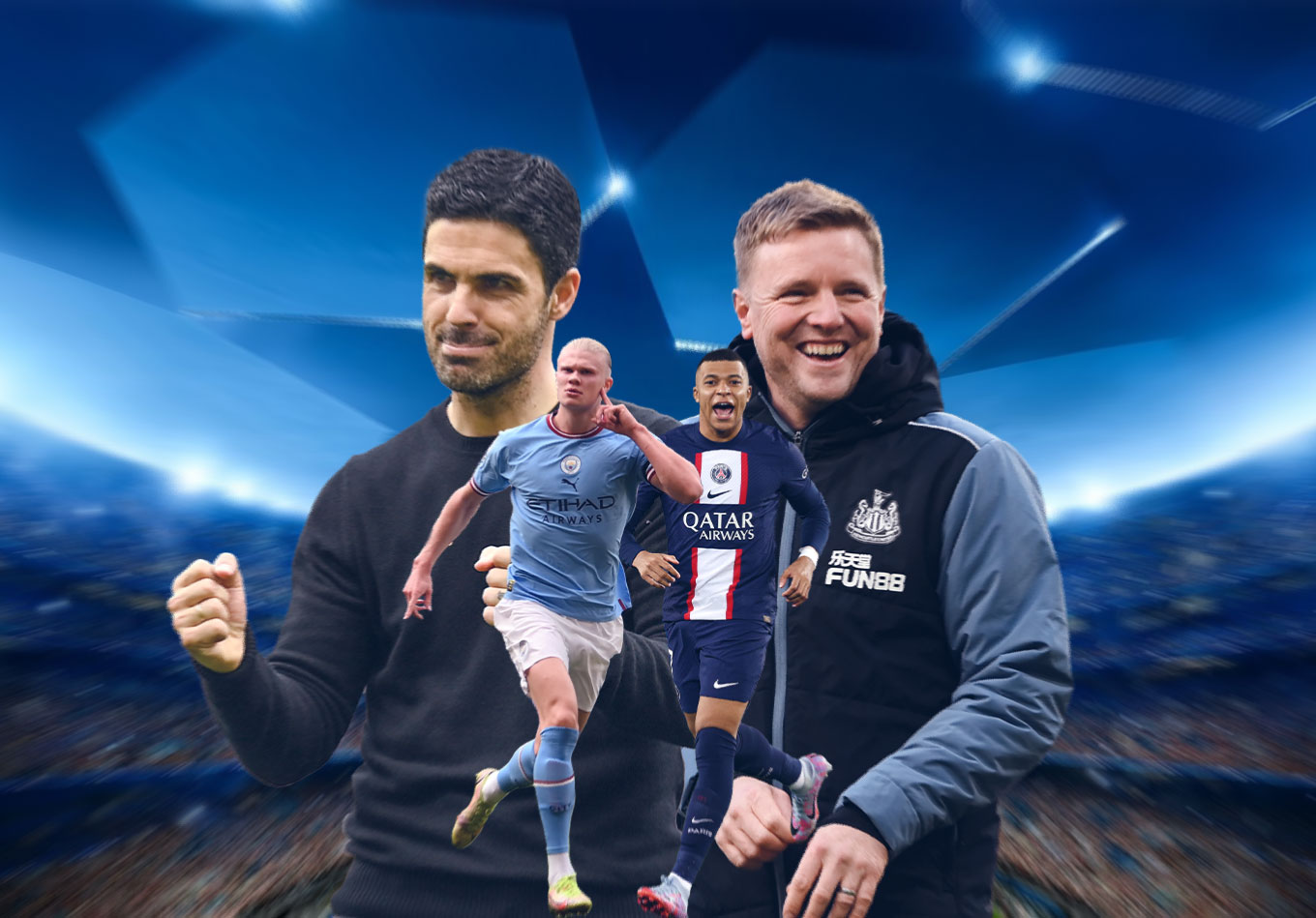With the 2023-24 UEFA Champions League about to get under way, we’ve taken a look at seven things to look out for in Europe’s premier club competition this season.
The 2023-24 UEFA Champions League is here – and it promises to be another riveting edition of the world’s greatest club competition. From the end of a legendary era to long-awaited returns, here are some of the most intriguing storylines to keep an eye on over the next eight months.
Can Manchester City Emulate Real Madrid?
Manchester City followed in the footsteps of Manchester United by winning the treble last season, becoming the eighth club to do so (also Celtic, Ajax, PSV, Barcelona, Inter Milan and Bayern Munich). Now, they have the opportunity to achieve something no English club has managed since 1980; retain their crown as champions of Europe (Nottingham Forest won back-to-back European Cups in 1978-79 and 1979-80, with Liverpool having done so in 1976-77 and 1977-78).
It’s only been done by a club from any country once during the Champions League era (since 1992). Real Madrid dominated the competition between 2015 and 2018, winning it three times in a row (having also won the first five European Cups back in the 1950s). This is Man City we’re talking about, though, a juggernaut who, at least at domestic level, have made domination a normality.

A Changing of the Guard
For the first time since the 2002-03 season, the Champions League will be without arguably its two greatest protagonists of all time; Cristiano Ronaldo and Lionel Messi – the two highest goalscorers in the history of the competition (number four on that list, Karim Benzema, is also gone). Who will fill the GOAT-shaped void?
The loss of those titans leaves Robert Lewandowski (90) and Thomas Müller (53) as the only active players in the top 10 for Champions League / European Cup goals. With Mohamed Salah (44) absent from Europe’s top table this season after Liverpool’s failure to qualify, and Neymar (50) joining Ronaldo and Benzema in the Saudi Pro League, there’s actually only one other active player in the top 20: Kylian Mbappé – who took his Champions League goal tally to 40 last term.
PSG and France’s main man is one of two obvious contenders to succeed Ronaldo and Messi as Champions League figureheads, the other being a certain Erling Haaland – who tasted glory in the competition for the first time as he top-scored with 12 goals en route to Manchester City’s maiden triumph last season, taking himself to 35 goals overall. Mbappé has yet to get his hands on a coveted Champions League winners medal, of course.
And, speaking of Haaland, rather terrifyingly (as it so often is with him), the Norwegian goal-bot could conceivably break into the top 10 Champions League scorers of all time in 2023-24. Assuming Pep Guardiola’s European champions reach at least the semi-finals in the defence of their title, all he needs to do is find the net at the same rate he did last term (1.09 goals per game) and he’ll draw level with Zlatan Ibrahimović and 2002-03 Champions League winner Andriy Shevchenko on 48 goals.

Arsenal Are Back
Few would disagree that Arsenal are one of the best teams in Europe right now and have been for the past 12 months. As for how Mikel Arteta’s side will fare on their Champions League return after six years away, well, only time will tell.
This will be Arsenal’s third full European campaign under Arteta, who guided them to the UEFA Europa League semi-finals in 2020-21 – where they lost to a Villarreal side managed by his predecessor in north London, Unai Emery – and reached the last 16 last time around, going out on penalties to Sporting CP. The latter exit came with the fairly big caveat that Arteta heavily rotated his starting 11 as he prioritised his side’s ultimately unsuccessful Premier League title pursuit.
But that was the Europa League. Making the Champions League a lesser priority, especially in the club’s first season back, simply won’t fly. So, the competition will provide a robust test of Arsenal’s squad depth – which they topped up further this summer with Declan Rice and Kai Havertz (fellow arrival Jurrien Timber looks set to miss an extended period after suffering an ACL injury on his Premier League debut), having brought in Leandro Trossard and Jorginho back in January.
Arsenal’s group appears favourable – they’ve been drawn alongside Sevilla, PSV and Lens – and they’ve already beaten the reigning European champions term, defeating Manchester City on penalties to win the Community Shield in August. On the whole, things seem to bode well, but they do have a considerable monkey on their back, having gone out at the last-16 stage in each of their last seven Champions League participations, most recently going further in 2009-10, at which time Arteta was still playing… for Everton.
Newcastle United’s New Era
If Arsenal’s return to the Champions League was somewhat overdue, Newcastle United’s comes ahead of schedule. In the first full season following their Saudi-backed takeover, Eddie Howe’s men stormed to fourth in the Premier League, their best finish since coming third in 2002-03 – the last time they appeared among Europe’s elite.
But there’s a sense that Newcastle could be in for a slightly rude awakening. Amid a lacklustre start to this year’s Premier League campaign, which saw them lose three on the spin after thrashing Aston Villa 5-1 on the opening weekend, they find themselves in the 2023-24 Champions League’s group of death along with PSG, 1996-97 winners Borussia Dortmund and seven-time champions of Europe, AC Milan. A 1-0 win over Brentford at the weekend gives them some momentum to take into their Champions League campaign.
Their spending power may eclipse that of Dortmund and Milan – as aptly demonstrated by their summer signing of Sandro Tonali from the latter – but Newcastle are effectively rookies at this level. Tonali (18 appearances) and captain Kieran Trippier (30) aside, their squad is lacking in Champions League experience; for many players, it’s something of a step into the unknown. After Tonali, the players with the next most Champions League appearances are Fabian Schär (13) and back-up goalkeepers Loris Karius (13) and Martin Dúbravka (6). The only other players in the squad to have featured in the UCL before are Sven Botman, Joelinton, Javier Manquillo (5 games each), Bruno Guimarães (4), Harvey Barnes and Alexander Isak (both 1).
Newcastle can’t be knocked out in the same way they were 20 years ago, though, when they featured in the last ever Champions League second group stage, finishing third in a group dominated by Barcelona and Inter Milan. When they step out at San Siro on Tuesday, it will end the longest ever gap between Champions League games for an English club (20 years and 184 days – a ‘Messi and Ronaldo’ ago, you might say).
The New Boys
Any first-time Champions League qualifier usually comes with a decent backstory – and there’s no doubt this applies to 2023-24 newcomers Union Berlin. Die Eisernen (The Iron Ones) will be aiming to make a big splash on their competition debut.
The brilliant image above beautifully sums up Union’s incredible rise over the past five seasons. In 2018-19, they won promotion to the Bundesliga for the first time in their history – having played in the fifth tier of German football only 13 years earlier. They breezed to seventh in their first top-flight campaign – before recording finishes of seventh and fifth, before securing fourth last season, earning them automatic qualification for the Champions League.
Union’s squad contains few household names, if any outside of former Juventus and Italy defender Leonardo Bonucci, but their meteoric ascent has been built on togetherness; on being better than the sum of their parts – overseen the whole way by manager Urs Fischer, who was appointed in the summer of 2018. They also boast one of the fastest players in this season’s Champions League in Suriname forward Sheraldo Becker, who recorded a top speed of 36.6km/h in the Bundesliga last season, behind only Borussia Dortmund’s Karim Adeyemi (36.7km/h) and ahead of Bayern Munich’s Alphonso Davies (36.5km/h). There is also the experience of 36-year-old right wing-back and captain Christopher Trimmel, who’s been with the club since their second-tier days.
Drawn into a group also containing Real Madrid and Serie A champions Napoli, Union will have their work cut out to reach the knockout stage – perhaps even more so following the entirely understandable decision to play their home games at the 74,667-seater Olympiastadion (home of local rivals Hertha Berlin) instead of their 22,012-capacity, mostly terraced Stadion An der Alten Försterei home – but that won’t diminish the romance of their story.
We must mention Royal Antwerp, too. After clinching their first Belgian title for 66 years in astonishingly dramatic fashion, Antwerp take a seat at Europe’s top table for the first time since 1957-58. It’s the longest gap between Champions League / European Cup participations in the history of the competition – they even had a 12-year spell outside the top flight, only returning in 2017 – but it just goes to show… Never give up.
The Home of (European) Football
Wembley Stadium’s eighth Champions League final will mean that it has staged European football’s showpiece match at least twice as often as any other venue. In city terms, only Paris (six finals between two stadiums: the Stade de France and Parc des Princes) comes within at least three of London’s total of eight finals – with Munich set to hold its sixth next year, the second at the Allianz Arena (after four at Bayern’s previous home, the iconic Olympiastadion).
Jupp Heynckes’ Bayern beat Jürgen Klopp’s Borussia Dortmund to lift the 2012-13 Champions League in the last final at Wembley – which is one of eight stadiums to host the final of UEFA’s top club competition and its premier international competition, the European Championships (along with the aforementioned Stade de France and Olympiastadion, the Santiago Bernabeu in Madrid, Rome’s Stadio Olimpico, Rotterdam’s De Kuip, Vienna’s Ernst-Happel-Stadion, and Lisbon’s Estadio da Luz).
Wembley also belongs to an exclusive group of stadia that have hosted the holy trinity of Champions League, Euros and FIFA World Cup final (the above list minus the last three).

Spain Edge It Thanks to Sevilla
For the fourth time in Champions League / European Cup history, one national association has five teams in the competition. And, for the third time, that association is Spain. Barcelona, Real Madrid, Atlético Madrid, Real Sociedad and Sevilla are La Liga’s participants this time around.
The first quartet made up the top four in La Liga in 2022-23 as Sevilla slumped to 12th – their worst league placing since they finished bottom of the Spanish top flight in 1999-2000 – but the Andalusians will take part in the Champions League for the fourth season running because they went and did what they do best again last term – winning the Europa League for a record-extending seventh time.
Does having at least one more representative than every other nation give you a better chance of seeing your country’s flag at the final? Well, on the first occasion it happened, there was an all-Spanish, all-Madrid final between Real and Atlético. The next time, in 2017-18, an English side made the final – Liverpool were beaten by Real in Kyiv. Then, in 2021-22, when Villarreal were Spain’s ‘extra’ qualifier after winning the previous season’s Europa League, they lost to Liverpool in the semis – and Liverpool suffered déjà vu as they were defeated by Real in the final once more. So, to answer our question: theoretically, yes.
Enjoy this? Subscribe to our new football newsletter to receive exclusive weekly content. You should also follow our social accounts over on X, Instagram, TikTok and Facebook.
